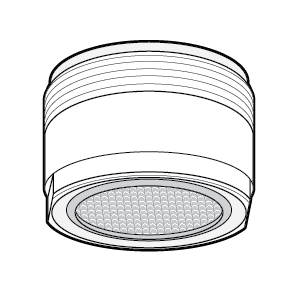There are many retrofit options that enable considerable savings to be realised at relatively low cost, most notably aerators, flow-restrictors and efficient showerheads (see table below). Some of these options may not be applicable where water pressure is low or electric showers are used, as is common in the UK and Ireland for example.
|
Feature |
Fitting |
Description |
Saving |
Applicability |
|
Showers |
Aerator/flow regulator |
Aerators are simple vacuum valves with an air intake that can be easily retrofitted between the tap and hose, or between the hose and showerhead. They introduce air into a pressurised water flow that expands when exiting the valve to create the feeling of higher flow rate, whilst generating less splashing to achieve a greater wetting efficiency. They may be combined with flow regulator valves that adjust flow space in response to pressure, ensuring a set maximum flow rate |
Up to 50 % reduction (6 L/min) in flow rate |
Universal where pressure at least one bar |
|
Showers |
Low-flow showerheads |
Low flow showerheads may incorporate aerators, or nozzle designs that generate fine droplets in an efficient spray pattern. |
Up to 50 % reduction (6 L/min) in flow rate |
Universal, when fitting new showers |
|
Toilets |
Dual flush mechanism |
Dual flush mechanisms are usually incorporated in new low-flush toilets, but may also be retrofitted to existing cisterns. These mechanisms consist of two buttons that allow the selection of a full flush (e.g. 6 L) for solid materials or a half flush (e.g. 3 L) to flush urine. Average water use is calculated assuming one third of flushes are full flushes and two-thirds are half-flushes. |
33 % |
Universal, new or retrofit |
|
Toilets |
Cistern displacement device |
Bags of water, granules or pebbles may be inserted into the cistern to reduce the water volume, or the float-arm may be adjusted to reduce the fill level. |
0.5 – 2 L per flush |
When fitting new frequent use public toilets |
|
Taps |
Aerator/flow regulator |
As for showers, aerators with or without flow regulators can be easily retrofitted by screwing on to the ends of taps to reduce the flow rate whilst maintaining wetting effectiveness and perceived flow. |
Up to 50 % reduction in flow rate |
Universal where pressure at least one bar |
|
Urinals |
Low-flush urinals |
Low-flush urinals require a maximum of 1.5 L per flush, and may be bought new or installed through retrofitting of existing urinal cisterns to reduce flush volume as described for toilets (above). |
Up to 3 L per flush |
Public toilets (and staff facilities) in hotels and restaurants, toilets in hostels and campsites |
|
Urinals |
Waterless urinals |
Waterless urinals may be bought new or installed through the retrofitting of existing urinal systems. Waterless urinals are designed to drain urine with no flushing while maintaining hygienic conditions and containing odours, using either: (i) a spring-loaded flap; (ii) a layer of oil floating on the surface of the trap liquid; (iii) plastic pads impregnated with chemicals to destroy bacteria and odours, inserted into the S-bend; (iv) weak negative pressure in the waste pipe induced by a small fan. |
|
|
Environmental benefits
Reduced use of hot water in low-flow taps and showers can save 301 and 677 kWh per fitting, respectively, conservatively assuming that on average the temperature of water used in showers and taps and showers has been elevated by 30 ºC and 20 ºC, respectively, using a 90 % efficient boiler.
In terms of total water savings in guest areas, installing low-flow showers throughout all guest rooms can achieve the greatest total savings, reducing typical guest water consumption by almost 10 %. This is followed by replacing bathroom taps (reduces total water consumption by approximately 5 %) and toilets (reduces total water consumption by approximately 3.5 %). Expressed per fitting, the greatest savings are associated with the installation of waterless urinals (up to 150 m3 per urinal per year) and low-flush (including dual flush) public toilets (up to 55 m3 per toilet per year). Savings for individual low-flow showers, low-flow basin taps and low-flush toilets equate to annual savings of 17.5, 11.7 and 9.1 m3/yr, respectively.

Reduced costs
All retrofit options offer short payback periods, ranging from 2 to 10 months.
Fitting combined flow-restrictors and aerators can realise almost immediate payback.
For public areas, considerable water and energy reductions associated with shower timers result in a short payback period of 6 – 8 months, justifying retrofitting.
Video
The use of this video on this site has been granted by The Travel Foundation.